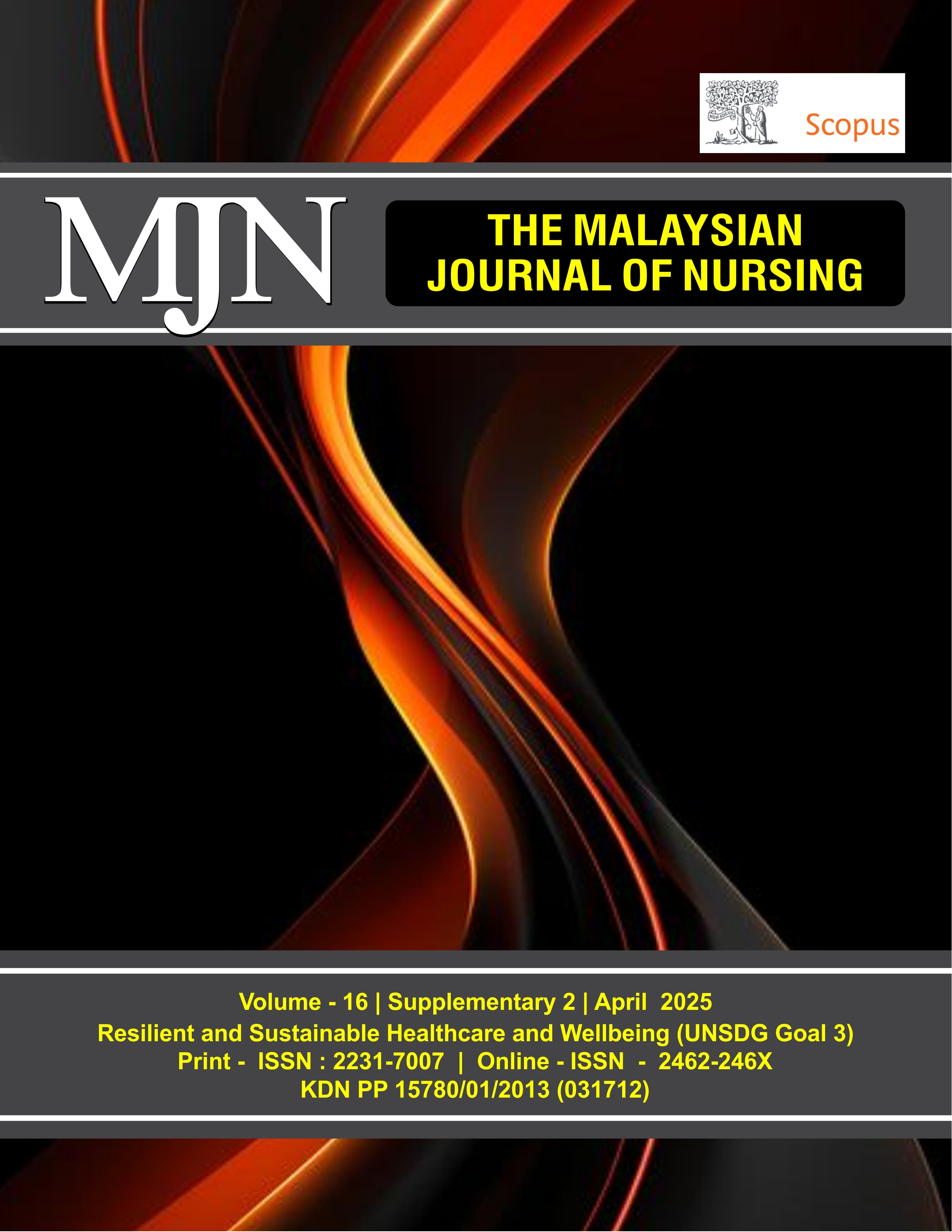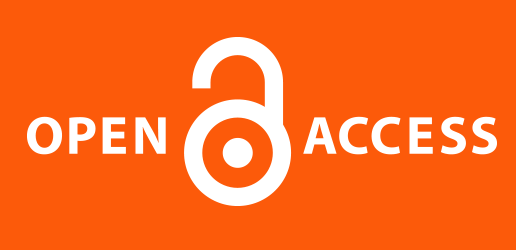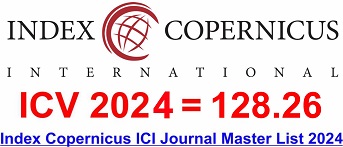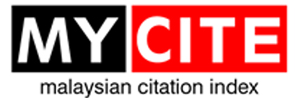The Effect of “QuakeGuard” Mobile Application on Resilience among Community Members in Disaster Prone Area in Sukabumi, Indonesia
DOI:
https://doi.org/10.31674/mjn.2025.v16isupp2.006Abstract
Background: Traditional disaster preparedness strategies often emphasise structural solutions, but the psychological and social dimensions of resilience have received less attention. Innovative approaches, such as mobile applications like "QuakeGuard," offer promising avenues to address this gap. Objectives: This study aimed to assess the effectiveness of the "QuakeGuard" mobile application in strengthening resilience among community members in disaster-prone areas of Sukabumi, Indonesia. Methods: A quasi-experimental study design with pre-test and post-test measurements was employed, with data collected at three repeated measurements. A total of 320 participants were recruited through convenience sampling and assigned to either the intervention group (n = 160) or the control group (n = 160). Community resilience was assessed using the Conjoint Community Resiliency Assessment Tool (CCRAT). Data analysis was performed using repeated measures ANOVA, Cohen’s d test, and generalised estimating equations (GEE). Results: The intervention group demonstrated significant improvements in community resilience over time compared to the control group (p < 0.05). The post-test resilience scores for the intervention group (Mean ± SD: 2.93 ± 1.54) were significantly higher than those for the control group (Mean ± SD: 2.56 ± 1.06, p = 0.012). GEE analysis showed a significant interaction effect (ß = 5.09, 95% CI: 2.10–8.75, p = 0.001). Conclusion: The "QuakeGuard" mobile application proved to be an effective tool for enhancing community resilience by providing user-friendly and culturally relevant disaster preparedness resources. Further studies should investigate the long-term effects and scalability of such interventions in diverse communities.
Keywords:
Community Resilience, Disaster Preparedness, Disaster Risk Reduction, Indonesia, Mobile Application, QuakeGuard, SukabumiDownloads
References
Agahari, W., Rinaldi, M., Wijayanti, A. P., & Setiadarma, E. G. (2018). Can mobile phones improve disaster preparedness? A survey-based analysis on the impact of AtmaGo. Centre for Innovation Policy and Governance. http://dx.doi.org/10.13140/RG.2.2.11694.56644
Agastya, W. D. (2024). Impact of Technology on Disaster Medicine in Low-Resource Settings: A Literature Review. Journal of Diverse Medical Research: Medicosphere, 1(2), 1-8. https://doi.org/10.33005/jdiversemedres.v1i2.25
Aliperti, G., & Cruz, A. M. (2020). Promoting built-for-disaster-purpose mobile applications: An interdisciplinary literature review to increase their penetration rate among tourists. Journal of Hospitality and Tourism Management, 44, 193–210. https://doi.org/10.1016/j.jhtm.2020.06.006
Arakawa, T., Yamada, A., & Sugimori, J. (2024). Development and Evaluation of a Game to Foster Sustainable Self Help and Mutual Help Education for Disaster Prevention. Sustainability, 16(19). https://doi.org/10.3390/su16198375
Ayuningtyas, D., Windiarti, S., Hadi, M. S., Fasrini, U. U., & Barinda, S. (2021). Disaster Preparedness and Mitigation in Indonesia: A Narrative Review. Iranian Journal of Public Health, 50(8), 1536–1546. https://doi.org/10.18502/ijph.v50i8.6799
Badan Nasional Penanggulangan Bencana (BNPB). (2022). Laporan Gempa Cianjur 21 November 2022. Retrieved from: https://gis.bnpb.go.id/Cianjur2022/. Accessed on 25th January 2023.
Champion, V. L., & Skinner, C. S. (2008). The health belief model. Health Behavior and Health Education: Theory, Research, and Practice, 4, 45-65. Retrieved from: https://shorturl.at/p9K6U. Accessed on 19th June 2024.
Cicek, D., & Kantarci, B. (2023). Use of mobile crowdsensing in disaster management: A systematic review, challenges, and open issues. Sensors, 23(3). https://doi.org/10.3390/s23031699
Cretney, R. M. (2018). Beyond public meetings: Diverse forms of community led recovery following disaster. International Journal of Disaster Risk Reduction, 28, 122-130. https://doi.org/10.1016/j.ijdrr.2018.02.035
Cvetković, V. M., Roder, G., Öcal, A., Tarolli, P., & Dragićević, S. (2018). The role of gender in preparedness and response behaviors towards flood risk in Serbia. International Journal of Environmental Research and Public Health, 15(12). https://doi.org/10.3390/ijerph15122761
Ezeonu, N. A., Hertelendy, A. J., Adu, M. K., Kung, J. Y., Itanyi, I. U., Dias, R. D. L., Agyapong, B., Hertelendy, P., Ohanyido, F., Agyapong, V. I. O., & Eboreime, E. (2024). Mobile Apps to Support Mental Health Response in Natural Disasters: Scoping Review. Journal of Medical Internet Research, 26. https://doi.org/10.2196/49929
Fakhruddin, B. S., Gluckman, P., Bardsley, A., Griffiths, G., & McElroy, A. (2021). Creating resilient communities with medium-range hazard warning systems. Progress in Disaster Science, 12. https://doi.org/10.1016/j.pdisas.2021.100203
Fuady, M., Munadi, R., & Fuady, M. A. K. (2021, February). Disaster mitigation in Indonesia: between plans and reality. In IOP Conference Series: Materials Science and Engineering, 1087(1). IOP Publishing. https://doi.org/10.1088/1757-899X/1087/1/012011
Haque, U., Hashizume, M., Kolivras, K. N., Overgaard, H. J., Das, B., & Yamamoto, T. (2012). Reduced death rates from cyclones in Bangladesh: what more needs to be done? Bulletin of the World Health Organization, 90(2), 150–156. https://doi.org/10.2471/BLT.11.088302
Hargono, A., Artanti, K. D., Astutik, E., Widodo, P. P., Trisnawati, A. N., Wardani, D. K., & Lioni, E. (2023). Relationship between disaster awareness and disaster preparedness: online survey of the community in Indonesia. Journal of Public Health in Africa, 14(9). https://doi.org/10.4081/jphia.2023.2376
Hazarika, M. K., Curran, C., & Nasrullah, S. (2018). Application of Space-based Technology and ICT To Strengthen Disaster Resilience: A Case Study in the Philippines. In Disaster Risk Governance Academic Seminar (p. 132). Retrieved from: https://www.rcrc-resilience-southeastasia.org/wp-content/uploads/2019/01/Report-Web-min.pdf#page=134. Accessed on 21st June 2023.
Kangana, N., Kankanamge, N., De Silva, C., Goonetilleke, A., Mahamood, R., & Ranasinghe, D. (2024). Bridging Community Engagement and Technological Innovation for Creating Smart and Resilient Cities: A Systematic Literature Review. Smart Cities, 7(6). https://doi.org/10.3390/smartcities7060147
Kankanamge, N., Yigitcanlar, T., Goonetilleke, A., & Kamruzzaman, M. (2020). How can gamification be incorporated into disaster emergency planning? A systematic review of the literature. International Journal of Disaster Resilience in the Built Environment, 11(4), 481-506. https://doi.org/10.1108/IJDRBE-08-2019-0054
Leykin, D., Lahad, M., Cohen, O., Goldberg, A., & Aharonson-Daniel, L. (2013). Conjoint community resiliency assessment measure-28/10 items (CCRAM28 and CCRAM10): A self-report tool for assessing community resilience. American Journal of Community Psychology, 52, 313-323. https://doi.org/10.1007/s10464-013-9596-0
Liu, H., Zhang, C., Ji, Y., & Yang, L. (2018). Biological and Psychological Perspectives of Resilience: Is It Possible to Improve Stress Resistance?. Frontiers in Human Neuroscience, 12, 326. https://doi.org/10.3389/fnhum.2018.00326
Paliling, A., Nurhidayani, A., & Pineng, M. (2022). Fundamental Design of Flood Management Educational Games Using Virtual Reality Technology. International Journal of Online & Biomedical Engineering, 18(3). https://doi.org/10.3991/ijoe.v18i03.27787
Patel, S. S., Rogers, M. B., Amlôt, R., & Rubin, G. J. (2019). What do we mean by ‘community resilience’? A systematic literature review of how it is defined in the literature. PLoS Currents, 9. https://doi.org/10.1371/currents.dis.db775aff25efc5ac4f0660ad9c9f7db2
Paul, J. D., Bee, E., & Budimir, M. (2021). Mobile phone technologies for disaster risk reduction. Climate Risk Management, 32. https://doi.org/10.1016/j.crm.2021.100296
Rogers, R. W. (1975). A Protection Motivation Theory of Fear Appeals and Attitude Change. The Journal of Psychology, 91(1), 93–114. https://doi.org/10.1080/00223980.1975.9915803
Ruszczyk, H. A., Upadhyay, B. K., Kwong, Y. M. C., Khanal, O., Bracken, L. J., Pandit, S., & Bastola, R. (2020). Empowering women through participatory action research in community-based disaster risk reduction efforts. International Journal of Disaster Risk Reduction, 51. https://doi.org/10.1016/j.ijdrr.2020.101763
Saravanan, V., & Garren, S. J. (2021). Baseline framework for assessing community resilience using a balanced index approach and spatial autocorrelation in the Mill river watershed, Nassau County, New York. International Journal of Disaster Risk Reduction, 66. https://doi.org/10.1016/j.ijdrr.2021.102621
Syukron, M., Oktari, R. S., & Fahmi, M. (2024). Mobile Applications for Enhancing Community Resilience in Disaster-Prone Areas: A Systematic Review. International Journal of Disaster Risk Reduction, 56. https://doi.org/10.1016/j.ijdrr.2024.102086
Twigg, J. (2019). Characteristics of a Disaster-Resilient Community: A Guidance Note (Version 2). University College London, UK. Retrieved from: https://www.ucl.ac.uk/hazard-centre/resources/working-papers/2.pdf. Accessed on 18th July 2023.
Twomlow, A., Grainger, S., Cieslik, K., Paul, J. D., & Buytaert, W. (2022). A user-centred design framework for disaster risk visualisation. International Journal of Disaster Risk Reduction, 77. https://doi.org/10.1016/j.ijdrr.2022.103067
United Nations Office for Disaster Risk Reduction (UNDRR). (2022). Building disaster resilience: A study of disaster events and financial lending streams. Retrieved from: https://www.undrr.org/media/85951/download?startDownload=20241226. Accessed on 24th May 2023.
Published
How to Cite
Issue
Section
License
Copyright (c) 2025 The Malaysian Journal of Nursing (MJN)

This work is licensed under a Creative Commons Attribution-NonCommercial-NoDerivatives 4.0 International License.



































